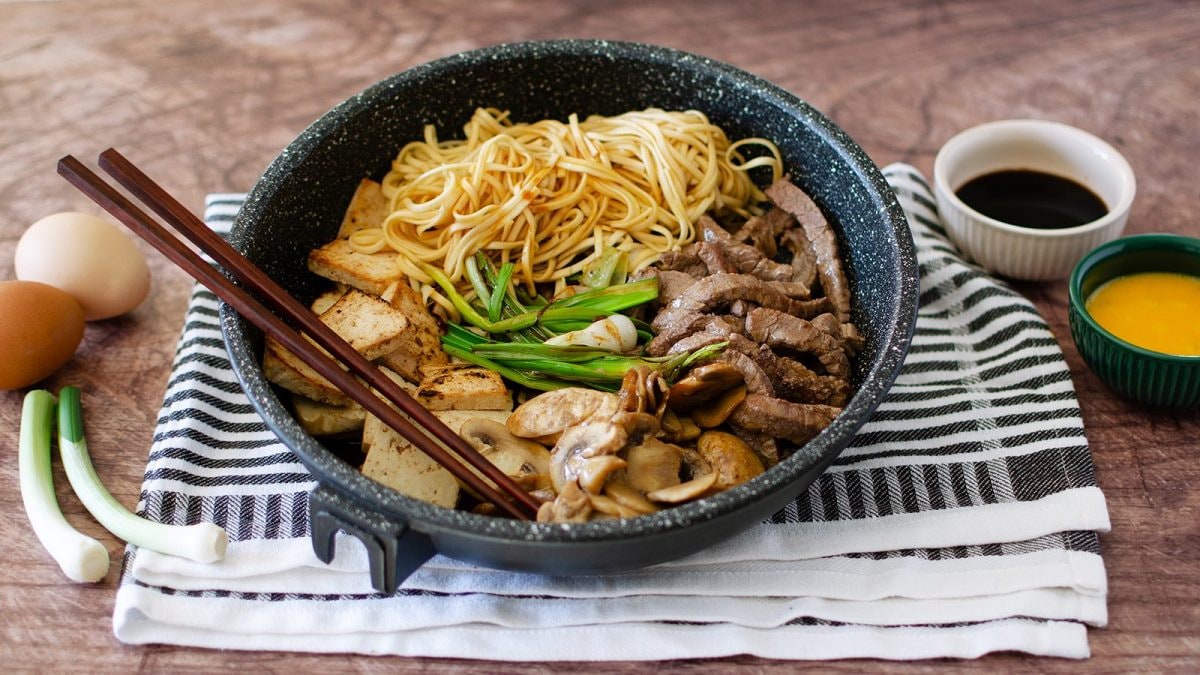
Homemade Sukiyaki is a typical Japanese cuisine recipe, enjoyed especially in winter, during bonenkai, the end-of-year celebration, family gatherings or special occasions. It is a main one pot dish in nabemono style, in which the ingredients are cooked in a single iron or clay pan with low edges, positioned on a portable stove and placed in the center of the table: perfect for a dinner with friends, to be consumed strictly with wooden chopsticks, it will leave your guests speechless.
In our version, simple and accessible to everyone, mix the soy sauce with the mirin and sugar, then pour a drizzle of extra virgin olive oil and half of the seasoning in a large saucepan, then arrange, well separated from each other, the beef carpaccio, the diced tofu, the sliced mushrooms and the sliced spring onions. As soon as these are cooked and caramelized, add the wheat noodles, boiled for a few minutes in boiling salted water, and leave to flavor for a few moments, sprinkling everything with the remaining sauce. Finally, serve the dish accompanied with beaten eggs in individual bowls, in which to dip each bite.
What is Japanese Sukiyaki? (And How to Pronounce It)
Sukiyaki (pronounced "Soo-kee-yah-kee") is a beloved Japanese hot pot dish with a rich history dating back to the Meiji era (1868–1912), a time when Japan began embracing Western influences, including the consumption of beef, which had been largely avoided for centuries due to Buddhist traditions. Sukiyaki consists of thinly sliced beef cooked alongside a variety of vegetables, tofu, and noodles in a sweet-savory broth made from soy sauce, sugar, and mirin. Typical ingredients include thinly sliced beef, shiitake mushrooms, enoki mushrooms, napa cabbage, onions, tofu, shirataki noodles, and a raw egg for dipping the cooked ingredients. This dish is often enjoyed communally, making it a popular choice for gatherings, especially during colder months.
What Are the 2 Types of Sukiyaki?
Emblem of conviviality and sociability, it is prepared with different foods, cooked over a very low flame with a mixture of soy sauce, sugar and mirin; the classic sukiyaki includes beef, cut into thin slices, vegetables and noodles. In Japan it is made with different methods, which vary from region to region: in Kansai, for example, the meat is cooked completely together with the vegetables, then the sauces are added; in Kanto, instead, dashi broth is used, which is heated and then used to boil the rest of the ingredients.
What is The Difference Between Shabu Shabu and Sukiyaki?
Sukiyaki is a sweeter, richer dish where thinly sliced beef and other ingredients are cooked in a soy sauce-based broth with sugar and mirin, creating a deep umami flavor. The ingredients simmer together, and the cooked food is often dipped in raw egg before eating. Shabu shabu, on the other hand, is a lighter, more delicate hot pot where ingredients are swished briefly in a plain, kombu-based broth. The name “shabu shabu” mimics the sound of swishing the meat in the hot broth. Instead of a sweet sauce, it’s typically served with ponzu (citrusy soy sauce) or sesame dipping sauce for added flavor.
Pro Tips for The Best Kansai Style Beef Sukiyaki
- Freeze the beef slightly before slicing: This makes it easier to cut paper-thin slices at home.
- Cook ingredients in small batches to maintain flavor and texture.
- Sukiyaki tastes best when eaten hot, straight from the pot, with friends or family!
What Cut of Beef Should I Use for Sukiyaki?
For sukiyaki, the best cut of beef is thinly sliced, well-marbled beef, as it cooks quickly and absorbs the sweet-savory broth beautifully. The most common cuts used are:
- Ribeye – A perfect balance of marbling and tenderness, making it the most popular choice.
- Sirloin – Slightly leaner but still tender and flavorful.
- Chuck Roll – A more affordable option with good marbling, ideal for rich flavor.
The beef is usually sliced paper-thin (about 1–2mm thick), either by a butcher or using a very sharp knife when the meat is slightly frozen for easier slicing. High-quality wagyu beef is often preferred for its melt-in-your-mouth texture
Can I Skip the Raw Eggs?
Yes, raw eggs can be skipped in sukiyaki! While traditionally used as a dipping sauce, they are completely optional. Another alternative is using a soft-boiled or poached egg to achieve a similar creamy effect. Some people also opt for alternative dips like sesame sauce or ponzu for added flavor.
What Can I Serve With Sukiyaki?
A classic accompaniment is steamed white rice, which absorbs the delicious broth and enhances the overall experience. Pickled vegetables, such as lightly pickled cucumbers, daikon, or umeboshi (pickled plums), add a tangy contrast to the dish. Miso soup is another great option, providing a comforting and mild flavor that complements sukiyaki’s bold taste. Japanese potato salad, which is creamy and slightly sweet, offers a nice textural contrast. Edamame, lightly salted and steamed soybeans, makes for a simple yet protein-rich addition. Cold tofu, known as hiyayakko, topped with soy sauce, scallions, and bonito flakes, provides a refreshing bite. To cleanse the palate, green tea is often served alongside sukiyaki, offering a warm and mild contrast to the dish’s richness.
Can I Add or Substitute Anything to This Sukiyaki?
If you like, you can customize the dish with your favorite vegetables: enoki, shitake or mixed mushrooms, Chinese cabbage or, alternatively, cabbage strips, and other seasonal vegetables. You can use dried or fresh egg noodles, or replace them with other types of oriental spaghetti, such as rice and soy noodles, wheat udon and sōmen, buckwheat soba or shirataki. The ideal beef for this preparation is Japanese wagyu, particularly tender and prized; in its place, you can use a good cut of meat, such as rump, fillet, topside or flank, available from your trusted butcher.
How Should I Eat Sukiyaki?
The traditional way to eat sukiyaki follows a communal and interactive dining experience. It is typically prepared and served directly at the table in a shallow cast-iron pot over a portable stove. To eat sukiyaki, diners use chopsticks to pick up the cooked ingredients directly from the pot.
The meal is eaten in stages, adding more ingredients as needed, making it a slow, communal, and interactive dining experience. Once most of the broth has been absorbed by the ingredients, some people finish the meal by adding udon noodles to the remaining sauce, allowing them to absorb the deep, concentrated flavors.
Can I Make Sukiyaki Ahead of Time?
Sukiyaki is best enjoyed fresh, but some components can be prepared ahead of time to save effort. Vegetables, tofu, and noodles can also be prepped and stored separately until ready to cook. However, the beef should be sliced just before cooking or stored properly to maintain its texture and freshness.
Can Japanese Sukiyaki Be Frozen?
Not really! If freezing sukiyaki, it's best to freeze only the broth and beef, then add fresh vegetables and noodles when reheating for the best taste and texture.
How to Store Japanese Sukiyaki
Allow the dish to cool before transferring it to an airtight container, keeping the broth and solid ingredients together for better preservation. Store it in the refrigerator, where it will last for up to 2 to 3 days. When reheating, use a pot over low heat or a microwave, adding a little water if needed to prevent the broth from becoming too concentrated. While the flavors may deepen, vegetables and noodles can become softer over time.
Ingredients
How to Make Japanese Sukiyaki
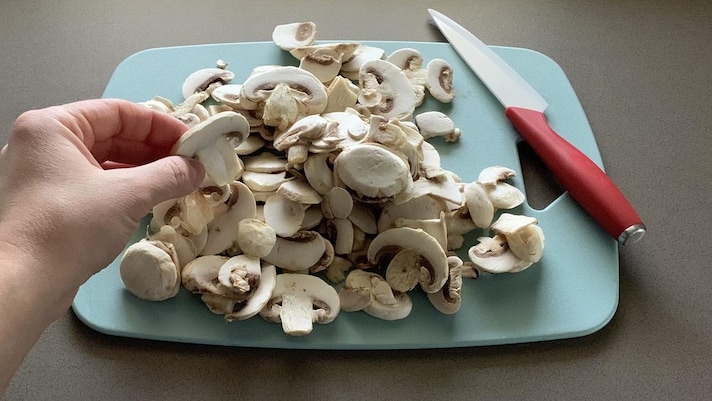
Cut the base of the stem of the mushrooms, then rub them gently with a sheet of kitchen paper to remove any earthy residue, then cut them into slices.
Cut the base of the stem of the mushrooms, then rub them gently with a sheet of kitchen paper to remove any earthy residue, then cut them into slices.
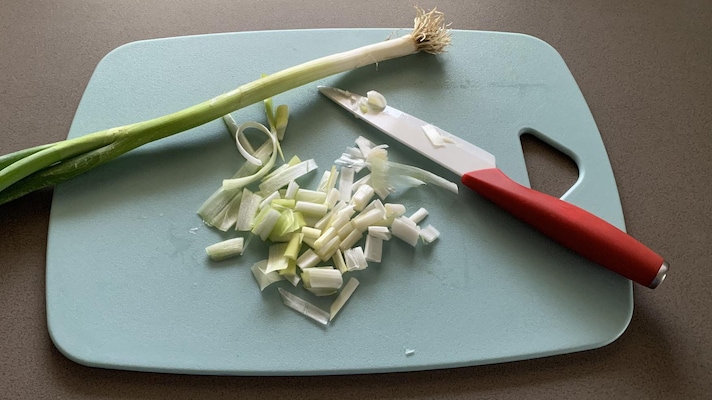
Chop the white part of the spring onion, leaving the green part whole.
Chop the white part of the spring onion, leaving the green part whole.
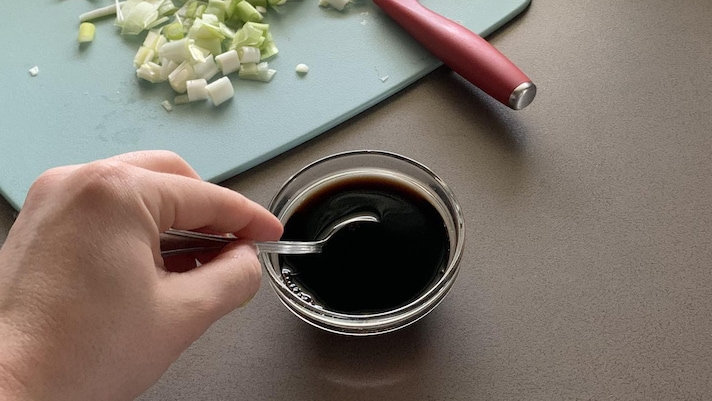
Prepare the dressing by mixing the soy sauce, mirin and sugar in a small bowl, until the latter is completely melted, then set it aside.
Prepare the dressing by mixing the soy sauce, mirin and sugar in a small bowl, until the latter is completely melted, then set it aside.
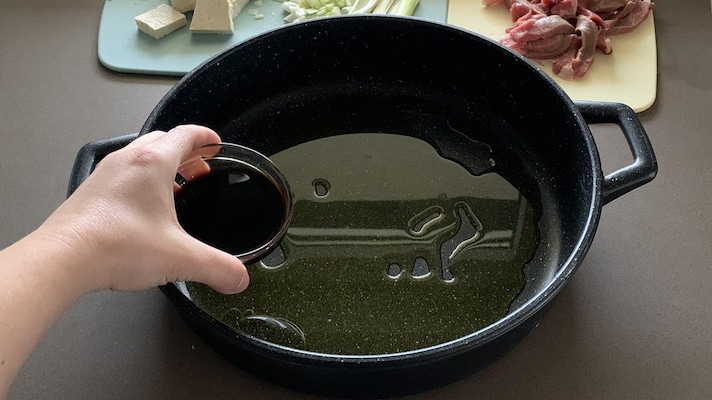
Boil the noodles in salted boiling water for 2 minutes, drain and immerse them in a bowl of cold water to stop the cooking. In the meantime, heat the extra virgin olive oil and half of the previously prepared dressing in a large saucepan.
Boil the noodles in salted boiling water for 2 minutes, drain and immerse them in a bowl of cold water to stop the cooking. In the meantime, heat the extra virgin olive oil and half of the previously prepared dressing in a large saucepan.
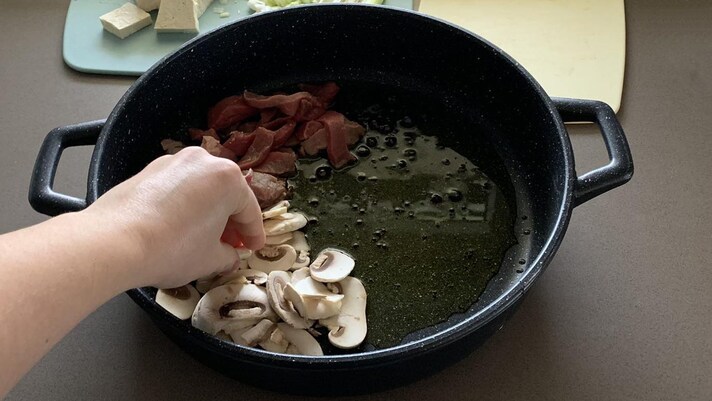
Arrange all the ingredients, including the beef, cut into bite-sized pieces.
Arrange all the ingredients, including the beef, cut into bite-sized pieces.
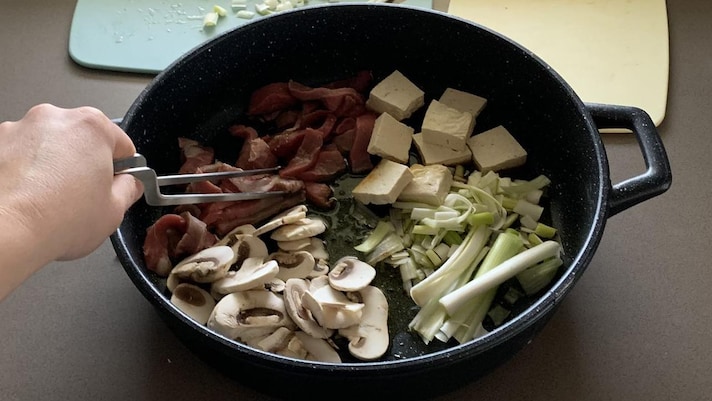
Arrange them in an orderly fashion, without mixing them together.
Arrange them in an orderly fashion, without mixing them together.
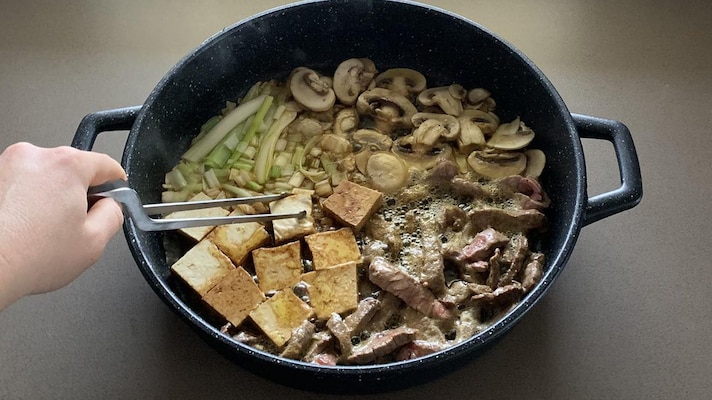
Let them caramelize over a low flame, turning them individually with kitchen tongs.
Let them caramelize over a low flame, turning them individually with kitchen tongs.
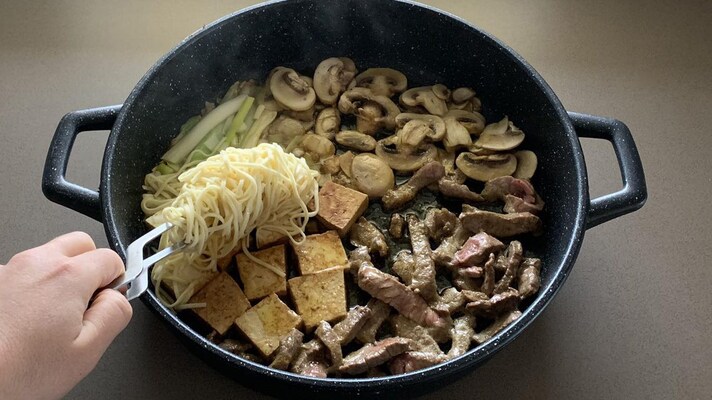
Once the meat is cooked, the ingredients are soft and the tofu is well caramelized, add the noodles, placing them on one side of the pan.
Once the meat is cooked, the ingredients are soft and the tofu is well caramelized, add the noodles, placing them on one side of the pan.
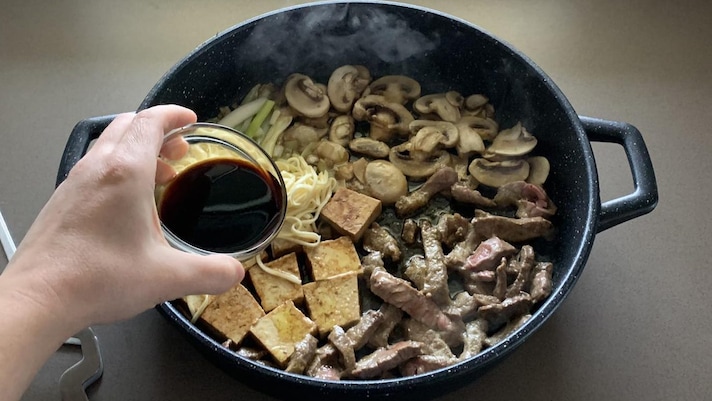
Sprinkle everything with the remaining half of the dressing and let it flavor for a few more moments.
Sprinkle everything with the remaining half of the dressing and let it flavor for a few more moments.
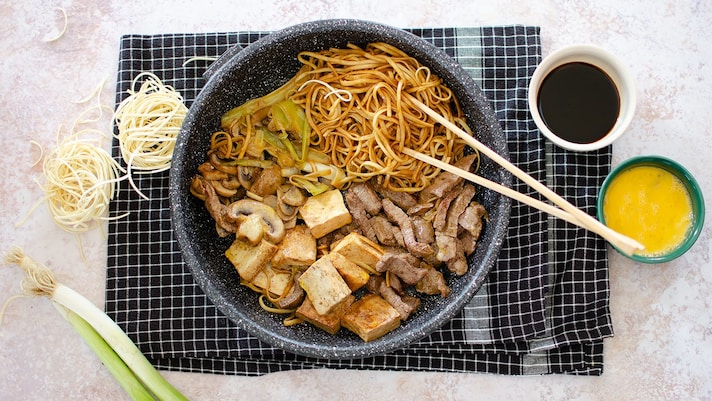
Beat a very fresh egg each in individual bowl, until the yolk and white are perfectly combined. Serve the sukiyaki with the eggs, in which to dip each bite. Enjoy!
Beat a very fresh egg each in individual bowl, until the yolk and white are perfectly combined. Serve the sukiyaki with the eggs, in which to dip each bite. Enjoy!
;Resize,width=767;)
